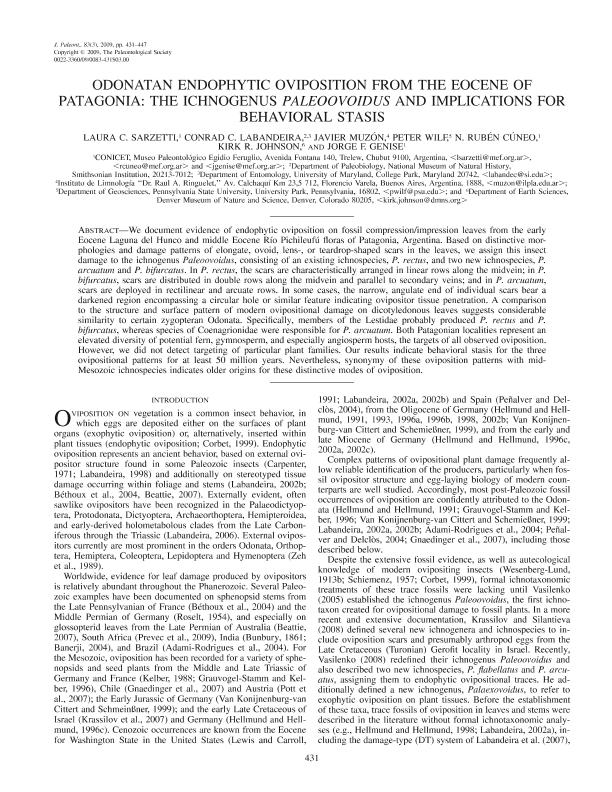Artículo
Odonatan endophytic oviposition from the Eocene of Patagonia: the ichnogenus Paleoovoidus and implications for behavioral stasis
Sarzetti, Laura Cristina ; Labandeira, Conrad C.; Muzon, Javier
; Labandeira, Conrad C.; Muzon, Javier ; Wilf, Peter; Cúneo, Néstor Rubén
; Wilf, Peter; Cúneo, Néstor Rubén ; Johnson, Kirk; Genise, Jorge Fernando
; Johnson, Kirk; Genise, Jorge Fernando
 ; Labandeira, Conrad C.; Muzon, Javier
; Labandeira, Conrad C.; Muzon, Javier ; Wilf, Peter; Cúneo, Néstor Rubén
; Wilf, Peter; Cúneo, Néstor Rubén ; Johnson, Kirk; Genise, Jorge Fernando
; Johnson, Kirk; Genise, Jorge Fernando
Fecha de publicación:
05/2009
Editorial:
Paleontological Society
Revista:
Journal of Paleontology
ISSN:
0022-3360
Idioma:
Inglés
Tipo de recurso:
Artículo publicado
Clasificación temática:
Resumen
We document evidence of endophytic oviposition on fossil compression/impression leaves from the early Eocene Laguna del Hunco and middle Eocene Río Pichileufú floras of Patagonia, Argentina. Based on distinctive morphologies and damage patterns of elongate, ovoid, lens-, or teardrop-shaped scars in the leaves, we assign this insect damage to the ichnogenus Paleoovoidus, consisting of an existing ichnospecies, P. rectus, and two new ichnospecies, P. arcuatum and P. bifurcatus. In P. rectus, the scars are characteristically arranged in linear rows along the midvein; in P. bifurcatus, scars are distributed in double rows along the midvein and parallel to secondary veins; and in P. arcuatum, scars are deployed in rectilinear and arcuate rows. In some cases, the narrow, angulate end of individual scars bear a darkened region encompassing a circular hole or similar feature indicating ovipositor tissue penetration. A comparison to the structure and surface pattern of modern ovipositional damage on dicotyledonous leaves suggests considerable similarity to certain zygopteran Odonata. Specifically, members of the Lestidae probably produced P. rectus and P. bifurcatus, whereas species of Coenagrionidae were responsible for P. arcuatum. Both Patagonian localities represent an elevated diversity of potential fern, gymnosperm, and especially angiosperm hosts, the targets of all observed oviposition. However, we did not detect targeting of particular plant families. Our results indicate behavioral stasis for the three ovipositional patterns for at least 50 million years. Nevertheless, synonymy of these oviposition patterns with mid-Mesozoic ichnospecies indicates older origins for these distinctive modes of oviposition.
Palabras clave:
Fossil Oviposition
,
Odonata
,
Paleoovoidus
,
Eocene of Patagonia
Archivos asociados
Licencia
Identificadores
Colecciones
Articulos(ILPLA)
Articulos de INST.DE LIMNOLOGIA "DR. RAUL A. RINGUELET"
Articulos de INST.DE LIMNOLOGIA "DR. RAUL A. RINGUELET"
Articulos(MACNBR)
Articulos de MUSEO ARG.DE CS.NAT "BERNARDINO RIVADAVIA"
Articulos de MUSEO ARG.DE CS.NAT "BERNARDINO RIVADAVIA"
Articulos(SEDE CENTRAL)
Articulos de SEDE CENTRAL
Articulos de SEDE CENTRAL
Citación
Sarzetti, Laura Cristina; Labandeira, Conrad C.; Muzon, Javier; Wilf, Peter; Cúneo, Néstor Rubén; et al.; Odonatan endophytic oviposition from the Eocene of Patagonia: the ichnogenus Paleoovoidus and implications for behavioral stasis; Paleontological Society; Journal of Paleontology; 83; 3; 5-2009; 431-447
Compartir
Altmétricas



